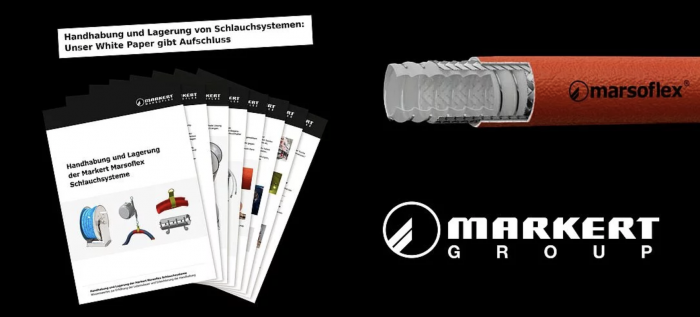Handling and storage of hose systems: Our white paper provides information

The longevity of hose assemblies, which are considered consumable components, is primarily influenced by how they are handled, stored, and, most importantly, the conditions under which they are used. In our white paper, you can delve deeper into the factors to consider when managing these systems and explore the additional equipment options offered by Markert.
The main culprits responsible for hose assembly failures are kinking, overrunning, and chafing. However, under optimal conditions, these assemblies can exhibit a service life of up to a decade or even longer.
Precise knowledge of the conditions of use and installation is crucial to define the most suitable hose configuration. Markert enhances service life and simplifies handling by providing a selection of common additional equipment for industrial hose assemblies:
- Hose Reel: This space-saving option ensures proper storage of hose assemblies, available in explosion-proof designs, with electric drives, or as mobile units.
- Hose Holder: Prevents the hose assembly from lying on the floor while maintaining the necessary bending radius during storage.
- Balancer/Hose Suspension: Offers robust load support for heavy hose assemblies, facilitating easy handling.
- Chafing Protection (Chafing Protection Spirals – Plastic, Electric Conductive, and Others): Reliable safeguard against external mechanical stress.
- Kink Protection (Various Kink Protection Options for PTFE Hoses and Others): Absorbs bending forces at the connection and reduces mechanical strain.
- Other Accessories:
- Heat Protection (Pyro-hose, Pyro-silicone tape, and Others): Shields against intense heat.
- Baffle Rings: Provides dependable protection for the fitting.
- Override Bridges: Utilized when hose assembly overrunning cannot be ruled out.
- Swivel Joints: Eliminates torsional forces.
- Hose Dogs: Employed for the effortless movement of hose assemblies from one location to another.
Proper Storage of Hose Assemblies:
When storing hoses and hose assemblies, adhere to the following guidelines:
- Maintain a cool, dry, and dust-free environment.
- Shield them from direct sunlight.
- Prevent contact with harmful substances.
- Avoid tension or kinks.
- Ensure they do not fall below the permissible bending radius.
- Protect hose ends.
- Rubber products should typically be stored between -10°C and +15°C, with exceptions up to +25°C. Encourage protection against air exchange through wrapping, airtight containers, or other methods.
Testing of Hose Assemblies:
In accordance with BG Chemie leaflet T002, it is advisable to subject hose assemblies to periodic testing. The frequency of inspection varies depending on the hose type and application, typically ranging from monthly to biennial assessments. For chemical hoses, a one-year interval has proven effective. The examination encompasses visual inspection, leakage testing, strength assessment, and measurement of electrical conductivity, with results documented in the test certificate.
For more information, please visit: https://www.markert-group.com
News Categories
- » NEWS HOME
- » Automation & Robotics
- » Industry 4.0
- » Material Handling
- » Sensors
- » Quality & Testing
- » Machine Vision
- » Laser & Optics
- » Metalworking
- » Motion Control & Drives
- » Hydraulics & Pneumatics
- » Process Industry
- » Renewable Energy
- » Agriculture
- » Home & Office Furniture
- » Environmental Tech









